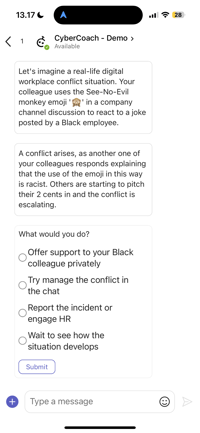Let's face it, most Code of Conduct training is just a snoozefest with the sole purpose of ticking a box. Employees are forced to watch boring videos or slideshows, and by the end of it, they're more confused than when they started. I've been through it. You have probably been too.

Why is delivering impactful compliance training so difficult?
It's definitely not because employees don't care. It's not even because people are inherently resistant to changing their behavior. Most people want to do the right thing and seek practical guidance. The main challenge is making training relevant and practical enough, so that employees can actually apply what they learn in real-life situations.
Training can't possibly cover all imaginable daily situations, so it's important to coach employees to think for themselves. Trust is motivating, so you want to offer training that builds employees' self-efficacy and confidence. You want employees to feel trusted to make the right call, instead of training them to follow a strict set of rules.
Sometimes Code of Conduct trainings avoid practical topics because they are uncomfortable and it feels risky. What if you end up hurting someone with training that is intended to protect everyone? But if you are afraid of addressing difficult topics, how can you expect your employees to feel like they can talk about them and report them?
Code of Conduct training is really where you need to "eat your own dog food". You can't teach inclusion inclusively, without peer-review and systematically involving a broad team to ensure you are covering what matters.
OK. So effective Code of Conduct training is about inclusive and individualized coaching that doesn't shy away from covering sensitive and controversial topics in practice. How do we build that?
Let's look at some do's and don'ts. Whether you have an entire team of learning experts to design engaging content tailored to your audience, or need to hack something together with limited resources, these principles can help you build training that works.
| Do's |
| Provide anonymous training and record training completion (to demonstrate compliance) with employee consent after training has been successfully been passed. |
| Be clear about what you expect from employees in specific situations. |
| Educate on the real harm even unconscious discrimination and misconduct can cause. |
| Encourage low-threshold reporting, even anonymously. |
| Include scenarios relating to online behavior and social media. |
| Include scenarios relating to current issues to keep training fresh and relevant. |
|
Gather feedback and use it to improve the training program in the future.
|
| Don'ts |
| Don't be fuzzy about what identifiable information you collect about employee responses and how you use that information. |
| Don't avoid taking a stance on sensitive topics. |
| Don't "motivate" employees through fear of disciplinary action or termination. Employees should not have to fear punishments for honest mistakes that they report in a timely manner. |
There's a science to creating effective learning experiences, regardless of the training topic. Take a look at some of our other blog posts for more tips on how you can leverage it in your training program: Four Tips for Creating Effective Training and The Pedagogy Behind an Effective Security Awareness Training Program.
Still feel like you don't know how to get started?
We strive to enable all companies to deliver quality Code of Conduct training that works without a whole team available for creating it. CyberCoach trainings are always about practical daily work scenarios and are easily configurable to reflect the specific policies of the company.
With sensitive topics such as those covered in Code of Conduct training, safe and anonymous learning spaces like CyberCoach are even more important. By allowing employees to answer openly and honestly, without fear of judgment or retaliation, companies can promote a culture of inclusion and psychological safety. CyberCoach is always available directly in Teams and Slack, making it easy for employees to complete the training in apps they are already using.
What's up with the doggo in the first picture?
Some of you may remember the scandal dog meme from years ago. Ultimately, Code of Conduct training serves to avoid scandals. With quality Code of Conduct training, no one needs to look as guilty as this scandalous dog. So, naturally, it found its way on the training completion badge.
Not amused?
We asked ChatGPT to tell us some jokes about the scandal dog meme and our Code of Conduct training. Here are the best ones:
Still not amused?
Try learning with CyberCoach.